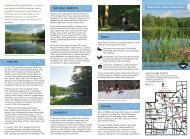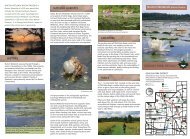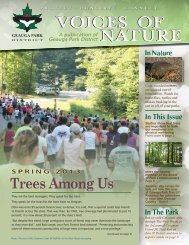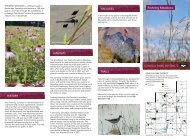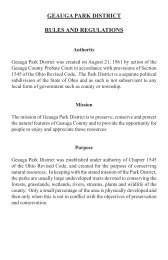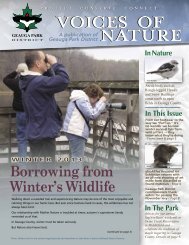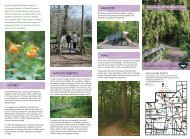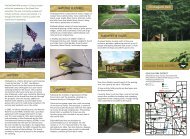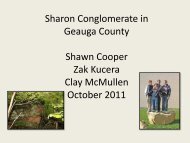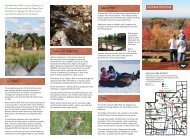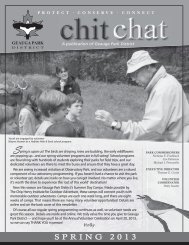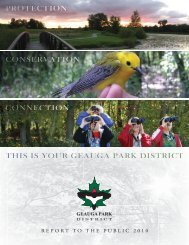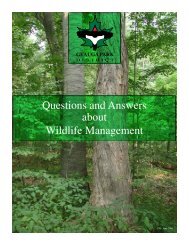What Makes Geauga a Gem - Geauga Park District
What Makes Geauga a Gem - Geauga Park District
What Makes Geauga a Gem - Geauga Park District
Create successful ePaper yourself
Turn your PDF publications into a flip-book with our unique Google optimized e-Paper software.
(continued from front cover)<br />
<strong>Geauga</strong>: a <strong>Gem</strong><br />
by Sandy Ward, Editor<br />
Headwaters<br />
When the conservation community thinks<br />
of <strong>Geauga</strong>, it doesn’t think maple syrup –<br />
first and foremost, it thinks headwaters,<br />
the birth of a water system, where water<br />
flows off surrounding land into a defined<br />
path.<br />
Among its biggest fans is Dr. Jim<br />
Bissell, renowned curator of botany<br />
and coordinator of natural areas at the<br />
Cleveland Museum of Natural History.<br />
“You protect the headwaters of the river<br />
streams in Northeast Ohio for all the<br />
rest of us,” Bissell said. “All the streams<br />
coming off <strong>Geauga</strong> County are exceptional<br />
quality, and those of us downstream have<br />
to thank the <strong>Park</strong> <strong>District</strong> for that.”<br />
Four river streams start in <strong>Geauga</strong>:<br />
• Northwest, deep ravines and steep<br />
forested slopes send<br />
the Chagrin River<br />
headwaters toward<br />
Lake County. Find<br />
these at The Rookery,<br />
Bass Lake Preserve,<br />
The West Woods,<br />
Orchard Hills <strong>Park</strong> and<br />
Sunnybrook Preserve.<br />
• Southeast,<br />
highlands at Swine<br />
Creek Reservation and<br />
Chickagami <strong>Park</strong> start<br />
one of the<br />
state’s finest rivers,<br />
the Grand, which flows toward Ashtabula<br />
and Lake, then back to Big Creek <strong>Park</strong>.<br />
• In central <strong>Geauga</strong>, exceptional<br />
wetlands send one branch of the upper<br />
Cuyahoga River headwaters from<br />
Observatory <strong>Park</strong>, where you can literally<br />
jump across it, through Burton Wetlands<br />
and Eldon Russell <strong>Park</strong>, then back toward<br />
Cleveland. (This is also the part of the river<br />
that gives it the “crooked river” name.)<br />
• A tiny tributary of the Mahoning River<br />
also starts south, in Troy Township, near<br />
Chickagami <strong>Park</strong>.<br />
While all are high-quality resources, the<br />
<strong>Geauga</strong> is graced with three major<br />
headwaters — and biodiversity<br />
to prove their high quality<br />
Chagrin River tributary at<br />
Observatory <strong>Park</strong> - Montville<br />
Chagrin River watershed in particular has<br />
the highest percentage of unpolluted,<br />
cold, spring-fed streams in Ohio, with<br />
about 50 percent of them in<br />
<strong>Geauga</strong>, said Amy Brennan,<br />
executive director of the<br />
Chagrin River Watershed<br />
Partners.<br />
“These streams are unique<br />
because they always have<br />
groundwater flow coming to<br />
them, which provides habitat<br />
for bugs and fish exclusively<br />
adapted to cold water,” she<br />
said. “Many <strong>Geauga</strong> residents<br />
rely on that same groundwater<br />
for their drinking water supply.”<br />
Speaking of drinking water,<br />
it’s a good thing Akron needs<br />
some – it preserves much of<br />
the Cuyahoga and surrounding<br />
wetlands through <strong>Geauga</strong><br />
County property it owns<br />
to secure its water source.<br />
“They’ve saved a lot of<br />
biodiversity,” Pira said.<br />
Intact flood plains on<br />
these preserves help slow<br />
down water and prevent<br />
flooding and erosion, said<br />
Pete McDonald, director of<br />
stewardship for Western<br />
Reserve Land Conservancy.<br />
Added Bissell, “Plus, you<br />
probably know there's one<br />
damselfly on the Cuyahoga River that's no<br />
place else in the state, and then there's<br />
the endangered Racket-tailed Emerald at<br />
Pine Brook<br />
Preserve and<br />
Lake Kelso,<br />
and a cool<br />
beetle not<br />
described<br />
until 1996<br />
found on<br />
several<br />
museum<br />
preserves in Ashtabula now<br />
found in <strong>Geauga</strong> County, and...“<br />
Racket-tailed Emerald dragonfly<br />
Biodiversity<br />
Bissell, Pira and other biologists find<br />
different plants and animals living<br />
in <strong>Geauga</strong> because of its unique<br />
microhabitats. Lake and Cuyahoga<br />
are more developed; Ashtabula, more<br />
influenced by agriculture.<br />
For instance, one particular Ohio<br />
endangered mussel is only found in the<br />
Cuyahoga River flowing out of East Branch<br />
Reservoir.<br />
A particularly special locale is near Burton<br />
Wetlands Nature Preserve and its beautiful<br />
Lake Kelso, a kettle hole depression;<br />
biologists call it the Cuyahoga Wetlands.<br />
Just south of there, White Pine Bog Forest<br />
is also a Registered<br />
Natural Landmark<br />
through the National<br />
<strong>Park</strong> Service.<br />
“It’s unique and<br />
pristine and just a<br />
really fine example<br />
of this type of<br />
white pine bog/fen<br />
forest that was here<br />
thousands of years<br />
ago but you can’t<br />
find it anymore,”<br />
Pira said.<br />
<strong>Geauga</strong> <strong>Park</strong> <strong>District</strong><br />
also protects some<br />
awesome fens,<br />
a type of wetland fed by mineral-rich<br />
groundwater.<br />
“Fens and bogs are some of the rarest<br />
communities anywhere, and they all<br />
deserve to be protected,” Bissell said.<br />
“The nice thing is, you can go to Lake<br />
Kelso, stand on the boardwalk and look<br />
at an outstanding glacial lake, fen system<br />
and typical boreal forest. It's a wonderful<br />
place to introduce people to bogs without<br />
getting their feet wet.”<br />
Wooded areas<br />
Like Lake and Ashtabula, <strong>Geauga</strong> <strong>Park</strong><br />
<strong>District</strong> houses many cool hemlock woods<br />
that harbor unique northern species<br />
normally found in Canada and Appalachian<br />
species such as northern nesting birds:<br />
Magnolia Warblers, Winter Wrens and<br />
Dark-eyed Juncos.<br />
“If they can find suitable micro-habitats – a<br />
little more moisture, shaded and cool all<br />
summer long – they will come down to<br />
<strong>Geauga</strong> County to nest,” Pira said.<br />
And while it’s neat to talk about the rare<br />
things, biologists also get excited about<br />
<strong>Geauga</strong>’s beech-maple forests.<br />
Lake Kelso in Burton Wetlands - Burton<br />
(continued on next page)<br />
www.geaugaparkdistrict.org • VOICES OF NATURE 3



